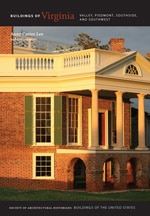
Despite the Williamsburg influence (see HR20), houses on Mulberry Road tend toward Federal rather than Georgian. One example is this house built for a furniture manufacturer. The two-story, five-bay brick house with frame wings has a slightly projecting, gabled central pavilion with a small, one-story semicircular balconied portico. Its entrance is framed by a traceried fanlight and enormous sidelights. Above a modillion cornice, the roof is sheathed in Buckingham slate. Heard also designed the two-story brick house (1947; 1018 Mulberry) with small one-story wings, a slate roof, and an elaborate wooden cornice. Its central-hall plan is indicated on the exterior by the spacing between the entrance and the two flanking bays. Here Heard plays with his Colonial Revival theme by adding detached sidelights to the frontispiece with its broken pediment and finial.








